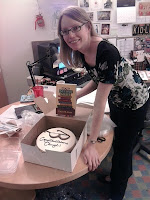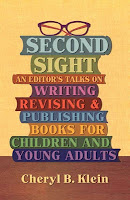This appeared today in the Publishers Weekly Children's Bookshelf e-newsletter:
Some PAQ (Possibly Asked Questions):
W. W. Norton!
I know! The Norton Anthologies! And Michael Lewis! And Patrick O'Brian (swoon)! I am thrilled.
How will the new book be different from Second Sight?
We are still talking this through, but my goal is that it will be a more complete and fully integrated guide to writing fiction for children and young adults, with a structure that walks writers through all the major elements of fiction and the writing process, accompanied by exercises, worksheets, and practical examples to help them apply the ideas on the page. Much of the material will be new, and much of what is taken from Second Sight will be extensively revised.
So you're not self-publishing anymore. Why not?
This new project started because I wanted to revise Second Sight into the book I describe above. As I thought about what it would take for me to do that, I realized that I was (and am) at a different place in my life than I was when I put Second Sight together, and I could really use the support, structure, challenge, and deadlines provided by a traditional publisher.
When people have asked me about self-publishing in the past, I've always said that neither traditional nor self-publishing should be the universal prescription for every writer and every project -- that the choice always depends upon the nature of the book, its market, and the writer's abilities and expectations in relation to the project. This was the right book and the right time for me to switch to traditional publishing, and I'm very grateful to Brianne for encouraging me and connecting me with Amy at Norton.
What will happen with Second Sight?
Second Sight is now going into its fourth printing (also hooray!), and should remain on sale for at least the next year and a half. It is still available through Amazon, at my appearances, or by contacting me directly at asterisk [dot] bks [at] gmail [dot] com. I also remain enormously grateful to everyone who has supported the book through the years, and everyone who's told me about their experiences with it, good and bad. (Much of that criticism is informing the new draft.)
What's it like to be on the other side of the editorial desk?
Pleasant and yet extremely weird.
What will the title of the new book be?
We're still working on that, but I have faith the right title will come in time. Most titles do. (And suggestions welcome.)
Edited to add: It arrived! The title will be The Magic Words: Writing Great Books for Children and Young Adults.
Thank you for your interest!
Amy Cherry at W. W. Norton has acquired Cheryl Klein’s book on writing children’s and young adult fiction. Previously self-published as Second Sight: An Editor's Talks on Writing, Revising, and Publishing Books for Children and Young Adults, Klein will be revising, re-writing, and updating the book. Klein is the executive editor at Arthur A. Levine Books/ Scholastic, where she served as the continuity editor for the last two books of the Harry Potter series, and she also teaches in the publishing program at the NYU School of Professional Studies. Publication is planned for September 2016; Brianne Johnson at Writers House negotiated the deal for World English rights.Hooray!
Some PAQ (Possibly Asked Questions):
W. W. Norton!
I know! The Norton Anthologies! And Michael Lewis! And Patrick O'Brian (swoon)! I am thrilled.
How will the new book be different from Second Sight?
We are still talking this through, but my goal is that it will be a more complete and fully integrated guide to writing fiction for children and young adults, with a structure that walks writers through all the major elements of fiction and the writing process, accompanied by exercises, worksheets, and practical examples to help them apply the ideas on the page. Much of the material will be new, and much of what is taken from Second Sight will be extensively revised.
So you're not self-publishing anymore. Why not?
This new project started because I wanted to revise Second Sight into the book I describe above. As I thought about what it would take for me to do that, I realized that I was (and am) at a different place in my life than I was when I put Second Sight together, and I could really use the support, structure, challenge, and deadlines provided by a traditional publisher.
When people have asked me about self-publishing in the past, I've always said that neither traditional nor self-publishing should be the universal prescription for every writer and every project -- that the choice always depends upon the nature of the book, its market, and the writer's abilities and expectations in relation to the project. This was the right book and the right time for me to switch to traditional publishing, and I'm very grateful to Brianne for encouraging me and connecting me with Amy at Norton.
What will happen with Second Sight?
Second Sight is now going into its fourth printing (also hooray!), and should remain on sale for at least the next year and a half. It is still available through Amazon, at my appearances, or by contacting me directly at asterisk [dot] bks [at] gmail [dot] com. I also remain enormously grateful to everyone who has supported the book through the years, and everyone who's told me about their experiences with it, good and bad. (Much of that criticism is informing the new draft.)
What's it like to be on the other side of the editorial desk?
Pleasant and yet extremely weird.
What will the title of the new book be?
We're still working on that, but I have faith the right title will come in time. Most titles do. (And suggestions welcome.)
Edited to add: It arrived! The title will be The Magic Words: Writing Great Books for Children and Young Adults.
Thank you for your interest!













